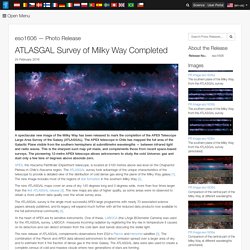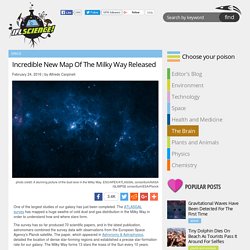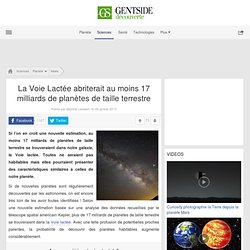

ATLASGAL Survey of Milky Way Completed. Eso1606 — Photo Release 24 February 2016 A spectacular new image of the Milky Way has been released to mark the completion of the APEX Telescope Large Area Survey of the Galaxy (ATLASGAL).

The APEX telescope in Chile has mapped the full area of the Galactic Plane visible from the southern hemisphere at submillimetre wavelengths — between infrared light and radio waves. This is the sharpest such map yet made, and complements those from recent space-based surveys. The pioneering 12-metre APEX telescope allows astronomers to study the cold Universe: gas and dust only a few tens of degrees above absolute zero. APEX, the Atacama Pathfinder EXperiment telescope, is located at 5100 metres above sea level on the Chajnantor Plateau in Chile’s Atacama region. The new ATLASGAL maps cover an area of sky 140 degrees long and 3 degrees wide, more than four times larger than the first ATLASGAL release [3]. At the heart of APEX are its sensitive instruments. Notes More information Links Contacts. Incredible New Map Of The Milky Way Released. One of the largest studies of our galaxy has just been completed.

The ATLASGAL survey has mapped a huge swathe of cold dust and gas distribution in the Milky Way in order to understand how and where stars form. The survey has so far produced 70 scientific papers, and in the latest publication, astronomers combined the survey data with observations from the European Space Agency's Planck satellite. The paper, which appeared in Astronomy & Astrophysics, detailed the location of dense star-forming regions and established a precise star-formation rate for our galaxy: The Milky Way forms 13 stars the mass of the Sun every 10 years. The project was possible thanks to APEX, the Atacama Pathfinder EXperiment telescope, in Chile, a precursor to the advanced Atacama Large Millimeter/submillimeter Array (ALMA), which is studying the universe at wavelengths between infrared and radio.
Dr. Direct evidence for a bar at the Galactic center. Le jour où notre galaxie, la Voie lactée, sera avalée par sa voisine la galaxie d'Andromède. Plus les galaxies grandissent et moins elles produisent efficacement de nouvelles étoiles.

A la place elles cannibalisent leurs voisines plus petites, un sort qui nous attend dans... 5 milliards d'années, d'après les spécialistes. Avez-vous déjà partagé cet article? Partager sur Facebook Partager sur Twitter Petite galaxie deviendra grande, mais comment s’opère ce phénomène ? Décidés à bien faire les choses, les chercheurs ont étudié 22.000 galaxies et 90 scientifiques se sont relayés sur le télescope anglo-australien de Nouvelles-Galles-du-Sud pendant sept ans.
The helical model - our Galaxy is a vortex. The Helical Model part 2 – Our Galaxy is a Vortex. NEW: get the sound track!

Part II of the Helical video series is finished, after two months of research, designing, editing and rendering… it shows our path through the Milky Way. Get the soundtrack here for free: Here are my notes on this video. It is far from perfect, and I have a lot to say about it. Vortex motion: Viral video showing Sun’s motion through galaxy is wrong. Image credit: DJ Sadhu, from the video.

I’ve been getting lots of tweets and email from folks linking to a slick-looking video, a computer animation showing the motion of the planets around the Sun as the Sun orbits around the Milky Way Galaxy. It’s a very pretty video with compelling music and well-done graphics. Phil Plait writes Slate’s Bad Astronomy blog and is an astronomer, public speaker, science evangelizer, and author of Death From the Skies! However, there’s a problem with it: It’s wrong. And not just superficially; it’s deeply wrong, based on a very wrong premise. Why? Normally I wouldn’t bother debunking stuff like this; wacky claims are made all the time and usually disappear on their own.
Un pulsar pour sonder le trou noir galactique. Le radiotélescope d’Effelsberg, en Allemagne, a permis de mesurer la polarisation du rayonnement émis par un pulsar proche du trou noir supermassif central.

MPIfR/Ralph Eatough Pour en savoir plus L'auteur Sean Bailly est journaliste à Pour la Science. 100,000 Stars. La Voie Lactée abriterait au moins 17 milliards de planètes de taille terrestre. Si l’on en croit une nouvelle estimation, au moins 17 milliards de planètes de taille terrestre se trouveraient dans notre galaxie, la Voie lactée.

Toutes ne seraient pas habitables mais elles pourraient présenter des caractéristiques similaires à celles de notre planète. Si de nouvelles planètes sont régulièrement découvertes par les astronomes, on est encore très loin de les avoir toutes identifiées ! Selon une nouvelle estimation basée sur une analyse des données recueillies par le télescope spatial américain Kepler, plus de 17 milliards de planètes de taille terrestre se trouveraient dans la Voie lactée. Avec une telle profusion de potentielles proches parentes, la probabilité de découvrir des planètes habitables augmente considérablement.
Avez-vous déjà partagé cet article? Partager sur Facebook Partager sur Twitter Néanmoins, certains critères doivent être réunis pour qu’une planète puisse être humainement habitable. 1242a - VISTA gigapixel mosaic of the central parts of the Milky Way. This striking view of the central parts of the Milky Way was obtained with the VISTA survey telescope at ESO’s Paranal Observatory in Chile.
This huge picture is 108 200 by 81 500 pixels and contains nearly nine billion pixels. It was created by combining thousands of individual images from VISTA, taken through three different infrared filters, into a single monumental mosaic. These data form part of the VVV public survey and have been used to study a much larger number of individual stars in the central parts of the Milky Way than ever before. Because VISTA has a camera sensitive to infrared light it can see through much of the dust blocking the view for optical telescopes, although many more opaque dust filaments still show up well in this picture.
This image is too large to be easily displayed at full resolution and is best appreciated using the zoom tool. Credit: ESO/VVV Survey/D. Artist's conception of the Milky Way annotated with arms, and galactic longitude and distances from the Solar System. Skymania News and Guide – How our Milky Way grew after Big Bang. Evolution of the Milky Way. Zooming Into The Center Of The Milky Way [720p] S Hubble Shows Milky Way is Destined for Head-On Collision. NASA's Hubble Shows Milky Way is Destined for Head-On Collision NASA astronomers announced Thursday they can now predict with certainty the next major cosmic event to affect our galaxy, sun, and solar system: the titanic collision of our Milky Way galaxy with the neighboring Andromeda galaxy.

The Milky Way is destined to get a major makeover during the encounter, which is predicted to happen four billion years from now. It is likely the sun will be flung into a new region of our galaxy, but our Earth and solar system are in no danger of being destroyed. This illustration shows a stage in the predicted merger between our Milky Way galaxy and the neighboring Andromeda galaxy, as it will unfold over the next several billion years. In this image, representing Earth's night sky in 3.75 billion years, Andromeda (left) fills the field of view and begins to distort the Milky Way with tidal pull. The scenario is like a baseball batter watching an oncoming fastball. La Voie lactée a le bras long. Vue d'artiste de la Voie lactée, qui intègre la découverte du prolongement du bras de l'Écu-Croix. © nasa/jpl-Caltech/R.

Benjamin (Univ. du Wisconsin) et R. Hurt (ssc-Caltech) Le disque de notre galaxie est plus symétrique qu’on ne le pensait, d’après la découverte de Thomas Dame et Patrick Thaddeus, astrophysiciens à Harvard, aux États-Unis. ST - 1982 : première carte gamma de la voie lactée. Mise à jour : 26/09/2011 En 1982, le premier satellite scientifique de l’ESA fournit la première carte de l’émission gamma de la Voie Lactée. L'instrument gamma de COS-B - Crédit ESA Lors du lancement de COS-B, le 9 août 1975, l’astronomie des hautes énergies en est à ses premiers pas.
Alors que dans le domaine visible des cartes du ciel avec des milliers de sources font l’objet d’études depuis l’Antiquité, seule une poignée de sources gamma ont été détectées grâce notamment aux satellites SAS-2 de la NASA et TD-1 de l’ESRO (l’ancêtre de l’ESA), tout deux lancés en... 1972 ! Pendant plus de 6 ans (au lieu des 2 ans prévus), le satellite de 278 kg observe la voûte céleste entre 70 MeV et 5 GeV pour une moisson de résultats scientifiques.
Le premier catalogue de sources gamma, répertoriant près de 30 objets, est ainsi publié en 1981.